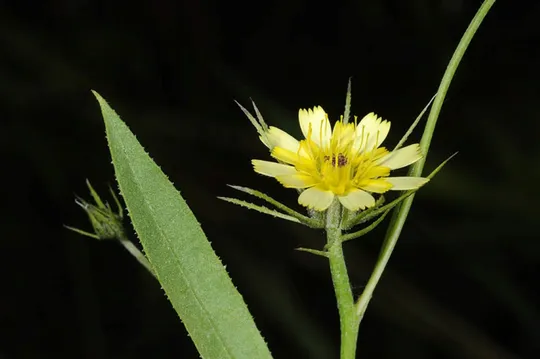European Umbrella Milkwort, Bearded Tolpis
Tolpis umbellata






Tolpis barbata now grows in
three regions on the coastal plain: the Acre Valley, the Sharon and Pleshet, on
ten documented sites and it is known to be extinct in eight sites. Most of T. barbata sites in Israel are found in the Sharon, mainly in the central
and southern Sharon: Bet Lid, Ilanot, Kfar Yona, east of Ramat HaKovesh, the Netanya
forest (Sergeants Grove), Hod HaSharon and the IMI compound (where it was found
only recently). Zeev Kuller and Aviva Rabinovich discovered T. barbata in the Hadera Forest in the northern Sharon in 1996.
The species is extinct in some other sites in the southern Sharon – from the
area of Ra’anana, Herzliya, Magdi'el and En Hai. Aviva Rabinovich first discovered T. barbata in the Acre Valley in the Liman Reserve in 1995.
In Pleshet the species is currently known only from Kiryat Ono (Joel Melamed,
Shir Vered), and this is also the southernmost site in which it is found in
Israel. In this region it is now extinct from the Petah Tikva area. The Flora Palaestina
notes T. barbata from the Carmel and from the
Gilboa as well, although we do not have sufficient evidence of this
In Israel – sand,
sandy red loam and red loam soils in the coastal plain, which contain significant
percentages of clay. Occasionally Tolpis barbata is found in Calicotome villosa garrigues.
In the Mediterranean Basin, its habitat is mainly sandy areas, often in
disturbed places.
The genus Tolpis consists of 12-20 species
concentrated in Europe, the Middle East and Africa. An important speciation center
that includes ten species is found in Macaronesia (Canary Islands, Madeira
Islands and the Azores). The genus belongs to the Lactuceae tribe in the sub-family
Liguliflorae in the family Asteraceae
(Compositae) family and is also
close to the genera Crepis and Taraxacum. Two species of Tolpis grow in the country – T. virgata,
a common biennial of shrublands, fields and roadsides, which reaches a height
of 80-100 cm and blooms early in summer and T. barbata, which is a rare, annual plant that
blooms earlier. In T. virgata the outer involucral bracts are shorter
than the inner ones.
·
There is a
significant decrease in the number of sites where Tolpis barbata
grows, despite the discovery of a new region and new sites during the surveys in
the1990s. The new findings reflect the increased sampling effort rather than an
expansion of its range.
·
T. barbata
often grows in small patches and the number of plants in each population does
not exceed a few dozen and only rarely hundreds or thousands of plants.
·
Land use changes
and the decrease in wild areas caused by urbanization and agriculture are the
main factor underlying the extinction of the populations as well as
constituting a threat to the remaining sites, especially those near towns or
villages. On most sites, the population is small, which in itself constitutes a
threat of extinction.
·
The only nature
reserve in which T. barbata is protected is
the Liman Reserve. All the Sharon and Pleshet populations are not located in
declared nature reserves.
·
T. barbata
has a broad global distribution and is probably not globally endangered.
Tolpis barbata should be highly
prioritized for conservation. Specific reserves should be established on
characteristic red loam sites, such as in Ilanot, Ramat HaKovesh and the IMI
compound, which also include T. virgata
and many other species that are endangered (Silene papillosa, Xolantha
guttata, Linaria pelisseriana and others). Tourism development in the
Netanya forest should be carried out carefully in order not to affect the T. barbata
populations as well as other unique species that grow there. It is important to
monitor all known populations to obtain an updated picture of the species
status.
Tolpis barbata is found around
the Mediterranean and in neighboring countries: it grows in Spain, Portugal,
France, and Italy, the countries of former Yugoslavia, Greece, Turkey, Syria,
Lebanon, Morocco, Algeria and Tunisia. It has also been reported from Bulgaria
and Romania. T. barbata also grows in all the Mediterranean
Islands: the Balearic Islands, Corsica, Sardinia, Sicily, Crete, the Aegean
Islands and Cyprus. It is a wildflower throughout the Canary Islands, but in
the Azores it is a naturalized species. It has been observed randomly in
England and there are reports from the Czech Republic of its being a naturalized
plant. It is found in California and Australia in disturbed areas and was introduced
there from Europe.
Tolpis barbata is a rare
annual plant of sandy and red loam soils in coastal regions. The number of
sites decreased and most of the populations on the remaining sites are small
and threatened by development. T. barbata is a peripheral
plant whose southern distribution limit is in Israel. It is not globally
endangered.
פולק, ג. 1984. מבחר מיני צמחים אופייניים לחמרה וכורכר / קיטה סוככנית. רתם 13 – הצומח של חמרה וכורכר במישור החוף. עמ' 147.
Current Occupancy Map
| 1000 squre meter pixel | 5000 squre meter pixel | 10000 squre meter pixel | |
|---|---|---|---|
| number of observations | 0 | 0 | 0 |
| in total pixels | 0 | 0 | 0 |
| Family | Asteraceae |
| Classification | On the endangered species list |
| Ecosystem | Mediterranean |
| Chorotype | Mediterranean |
| Conservation Site | Liman Nature Reserve, Ilanot |
| Rarity |
1
3
6
|
|---|---|
| Vulnerability |
0
3
4
|
| Attractiveness |
0
0
4
|
| Endemism |
0
0
4
|
| Red number |
1
3.7
10
|
| Peripherality | N |
| IUCN category | DD EW EX LC CR EN VU NT |
| Threat Definition according to the red book | Vulnerable |
 Based on:
Based on:






